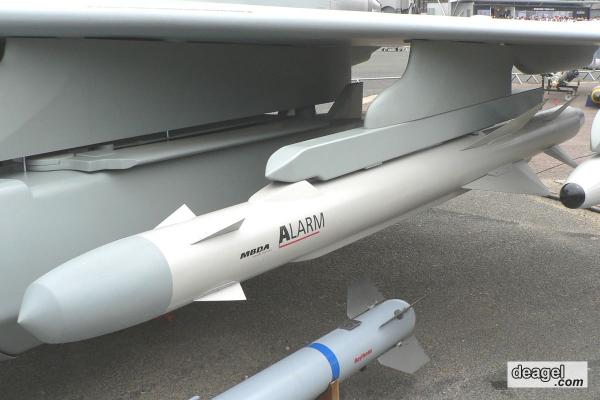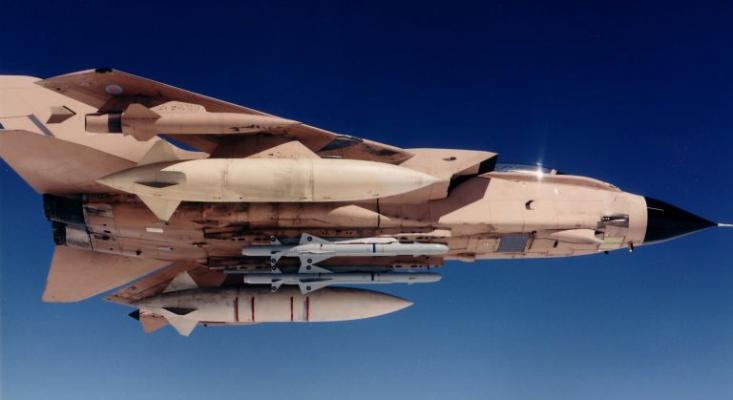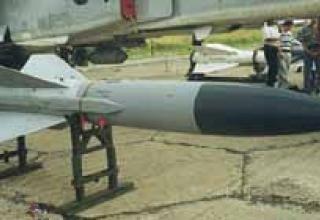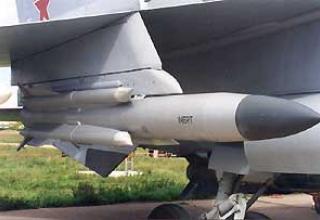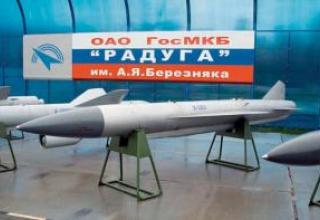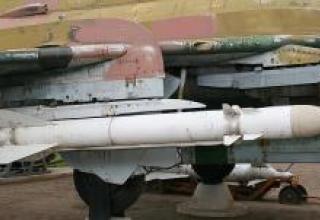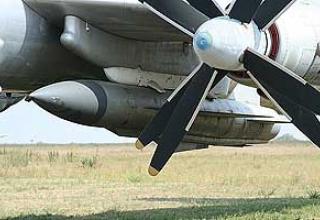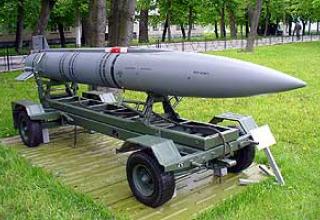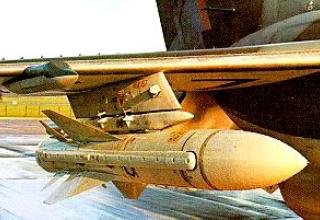ALARM (Air-Launched Antiradar Missile) aircraft missile with passive homing head is intended for destruction of enemy air defense systems radar controls, including medium- and long-range anti-aircraft missile radars.
The ALARM anti-surface missile (AS.37 Martel and AGM-45 Shrike) was created by Matra BAe Dynamics and Texas Instruments in accordance with the requirements of UK Air Force N 1228 to replace the obsolete AS.37 Martel and AGM-45 Shrike missiles of similar purpose. The research work was conducted from 1977 to 1980. The development contract was concluded in June 1983, the first launch of a new missile took place at the end of 1988. Tests of the missile were held at the China Lake test site (USA) from 1988 to 1990. The ALARM PRR was adopted for service in 1991. Initially, the planned volume of procurement of missiles for the Royal Air Force was 750 pieces. The ALARM rocket launcher is part of the armament of Tornado fighter-bombers, Harrier fighters, Hawk attack aircraft and Lynx multipurpose helicopters.
Composition:
The ALARM rocket is designed according to the normal aerodynamic scheme, with four small stabilizers at the front of the hull (see diagram). The missile casing is functionally divided into several compartments including: passive homing radar head, control unit (flight task unit), inertial control system, non-contact fuse with a safety executive mechanism, combat unit, marching solid rocket engine, steering and parachute compartments (see layout diagram).
Marconi Defence Systems solid-state broad-band PRNG, has a fixed four-way spiral wide-band antenna. According to the developer of PWGN, it is highly selective and resistant to countermeasures. The PWGN antenna fairing is made of a new synthetic material that provides less signal attenuation and distortion compared to ceramic fairings.
A characteristic feature of the ALARM PRR is that it can be used in the so-called barrage mode, in which the missile with the engine off slowly descends under the dome of the parachute, searching for the radar target. The missile's PRGSN has a high sensitivity and provides guidance of the radar antenna antenna pattern to the corresponding area of the side blades. Modern radars have a very narrow main beam and a low level of intensity of the side blades of the directional diagram, which, given the rotation of the antenna devices in the horizontal plane gives, from the point of view of the missile's PWGN, a pronounced pulsating nature of the radiation. In the final section, the trajectory of the ALARM PWR for all modes of application is almost vertical, which allows to use for guidance of the missile relatively constant field of radiation of the vertical blades of the radar antenna directivity of the target and reduces guidance errors due to re-reflection of signals from local objects. If the target stops emitting radiation, the radar is kept on course by the onboard inertial control system.
The missile's inertial control system is based on a free measuring module, which provides angular and linear motion measurement on three axes. Before the launch of the missile inertial control system of the PRR continuously receives information from the navigation system of the aircraft carrier.
The control unit includes a digital processor Zilog Z8002, which provides signal processing from the PRGSN and the inertial platform, solving the task of identifying a target and forming control commands. The processor allows for rapid reprogramming - the characteristics of the enemy radar and the priority of targets can be entered immediately before departure. The software is written in CORAL language. The control unit provides target identification by comparison with typical radar pulse sequences from the database and, depending on the target type, sets the height of the BC explosion above ground level. This operating algorithm is designed specifically to defeat the radar to detect low-flying targets whose antenna posts rise above ground level using a special tower. As a rule, the height of the blast is set at the level of the grating antenna or the control cabin of the radar.
The ALARM PIR combat unit is a shrapnel-flagged one designed by MBB. The combat unit is equipped with ready-made heavy hitting elements made of tungsten and is designed specifically for hitting antenna grids, electronic units and radar calculations. The non-contact Thorn EMI fuse is made on the basis of a solid-state laser and provides the specified height of the BC detonation.
The solid-propellant dual-mode marching engine with the possibility of reactivation, providing the possibility of using the missile in the barrage mode, developed by Bayern-Chemie. The engine is located in the central compartment of the rocket, is equipped with a charge of low-smoke mixed fuel and provides traction on the launch and marching mode in the ratio of 10:1. The engine nozzle is connected to the gas combustion chamber, laid on the axis of the rocket through two tail compartments.
In the steering compartment in the circular gap between the gas line and the rocket body there are four independent electric drives, providing the deflection of the aerodynamic rudders. The missile's tail compartment accommodates a parachute system consisting of a brake and main dome. After braking the rocket and opening the main parachute in the barrage mode, the system provides vertical descent of the rocket and a spiral scan of the space with the help of the PRGSN.
To launch the ALARM PRR (see diagram), special rail-mounted aircraft launchers (RSAs) are used. The missile descends from the rails with acceleration up to 4g. The command to unlock the aerodynamic rudders is given 0.5 s after the rocket leaves the rails.
The missile can be launched from a board of different carriers. The simplest interface of the ABS interface provides only the command to launch the PRR engine and provides the possibility of placing the missile on different carriers. In this case, the preparation of the flight mission and its entry into the missile's control system is performed at the airfield before departure.
The other variants of interface with the launch vehicle are performed on the basis of multiplex information exchange channel according to MIL STD 1553 standard. A limited version, designated Active Interface, provides transmission on board the PRR ALARM of data on the location and speed of the carrier aircraft in real time. The use of Active Interface removes restrictions on carrier maneuvers before starting the rocket.
In addition to the Active Interface capabilities, the full-scale MIL STD 1553 interface allows to quickly reprogram the rocket in flight to perform a new combat mission up to the moment of launch, as well as to test and verify the rocket systems with viewing the results on the multifunctional cockpit display.
Modes of operation.
ALARM has three main modes of operation, which depending on the type of carrier can be programmed before the flight or set on the suspension directly during the flight.
Direct attack is a tractional method of engaging the radar when the missile is launched on a pre-determined target and follows the most optimal trajectory. Capturing the target PWGN missile is carried out on the suspension of the target designation from the equipment of the aircraft carrier or on the trajectory. The maximum firing range in direct attack mode of a pre-prospected target is about 93 km. Immediately before the target, the missile executes a slide and attacks the target from above. If the target is lost, the missile can be redirected to another radar.
The second mode is barrage mode. In the second mode, the missile is launched from a carrier plane flying at low altitude at a distance of up to 40 km from the target. The missile is launched in the absence of direct visibility of the radar target. After the launch, the rocket gains an altitude of up to 12 km, after which the engine is turned off and the parachute opens, with the help of which the missile can barrage for about two minutes. In the process of reducing the radar missile searches for working enemy radars. When capturing the target of the WGSN parachute shoots off and PRR, running the engine, diving to the target.
The third mode - a combined use mode. In this mode, the missile is launched in direct attack mode, with the loss of contact with the target PRR rises to altitude and goes into barrage mode. This mode is used from high and medium altitudes of the launch vehicle and is optimal in case of action against mobile and marine air defense systems.
It is known that one of the ways to counteract PRR attacks is to reduce the time of the radar operation on the air by switching off the station completely or periodically. The duration of a pause in the radar operation is determined by the time of the PRR flight of the final trajectory section. The use of ALARM radar in the barrage mode, as well as the possibility of multiple multiple rocket launches in multiple phases, can make the value of such a pause unacceptably large for the normal operation of the air defense system. In this way, the radar can be disabled, if not by destroying it, but by forced shutdown.
Characteristics:
| Maximum firing range, km | 93 |
| Maximum flight speed, m/s | 695 |
| Dimensions, mm: - length - diameter - wingspan |
4300 230 720 |
| Starter weight, kg | 268 |
Testing:
The British Air Force first used ALARM in 1991 during the Gulf War, and these missiles were not yet in service and their tests were not completed by the beginning of hostilities. The Royal Air Force in the Gulf area had nine Tornado GR.1 fighter-bombers equipped with ALARM. The planes flew combat flights from Tabuk to Saudi Arabia. Loading of the planes, as a rule, was three rockets on the fuselage suspension. REPs were defended by a suspended Skyshadow container on one underwing pylon and a suspended container with a dipole deflector ejection machine and IR trap on another pylon. The launches were carried out at ranges from 8 to 100 km, at flight altitudes from 800 to 6000 m in horizontal flight with subsequent cabbling. MLRS carriers were generally in a warhead group or air defence suppression groups. In total, the Royal Air Force conducted 24 ALARM missions to suppress Iraqi air defenses and 52 combat missions during which 121 missiles were fired. The missiles were exhausted by mid-February, after which the U.S. Air Force was tasked with suppressing the Iraqi air defenses. Several launches failed due to technical failures of the launch pad missiles. Thus, the UK tested a new missile, which, according to Western military observers, helped accelerate its adoption.
During the aggression of NATO against Yugoslavia in 1999 it was reported that 6 ALARM missiles were used. There is no information about the effectiveness of the use.
Sources:
- "Bayern-Chemie"- Alarm
- Matra/BAe ALARM (Australian Aviation, June 1997 by Carlo Kopp)
- http://ru.wikipedia.org

